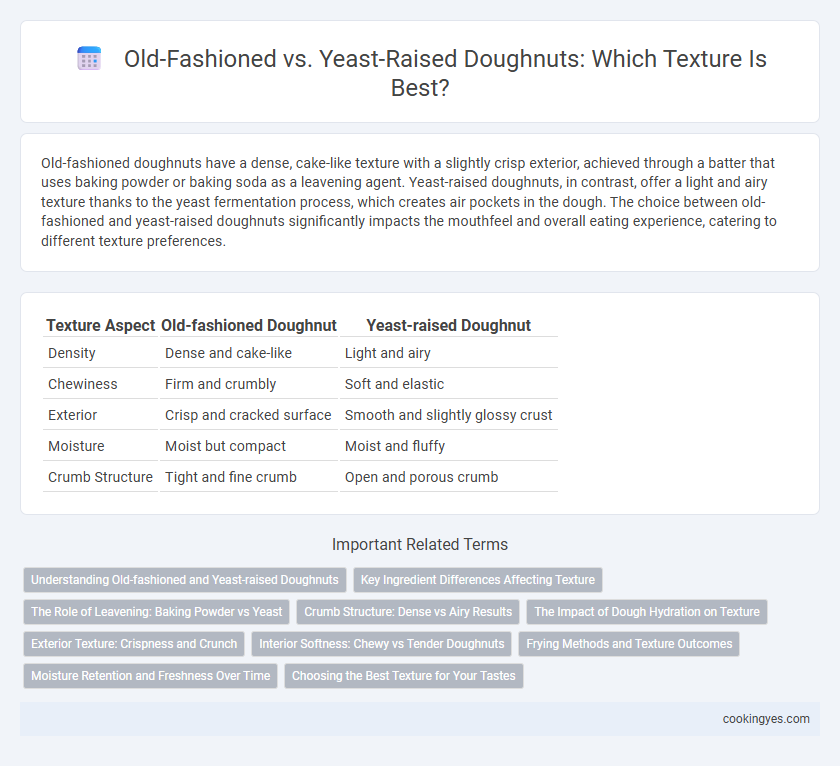Old-fashioned doughnuts have a dense, cake-like texture with a slightly crisp exterior, achieved through a batter that uses baking powder or baking soda as a leavening agent. Yeast-raised doughnuts, in contrast, offer a light and airy texture thanks to the yeast fermentation process, which creates air pockets in the dough. The choice between old-fashioned and yeast-raised doughnuts significantly impacts the mouthfeel and overall eating experience, catering to different texture preferences.
Table of Comparison
| Texture Aspect | Old-fashioned Doughnut | Yeast-raised Doughnut |
|---|---|---|
| Density | Dense and cake-like | Light and airy |
| Chewiness | Firm and crumbly | Soft and elastic |
| Exterior | Crisp and cracked surface | Smooth and slightly glossy crust |
| Moisture | Moist but compact | Moist and fluffy |
| Crumb Structure | Tight and fine crumb | Open and porous crumb |
Understanding Old-fashioned and Yeast-raised Doughnuts
Old-fashioned doughnuts feature a dense, cake-like texture with a cracked, crisp exterior due to chemical leaveners like baking powder, providing a rich, buttery flavor. Yeast-raised doughnuts offer a light, airy texture and subtle chewiness, achieved through fermentation that creates carbon dioxide bubbles, resulting in a soft, fluffy inside. Understanding these textural differences helps bakers and consumers choose doughnuts based on preference for crispiness versus fluffiness.
Key Ingredient Differences Affecting Texture
Old-fashioned doughnuts rely on chemical leaveners like baking powder, resulting in a denser, cakey texture with a crisp exterior. Yeast-raised doughnuts use yeast as the key leavening agent, creating a lighter, airy crumb with a chewy, pillow-like softness. The presence of yeast fermentation also develops gluten structure, contributing to the characteristic fluffy and elastic texture unique to yeast-raised doughnuts.
The Role of Leavening: Baking Powder vs Yeast
Old-fashioned doughnuts rely on baking powder as a chemical leavening agent, producing a denser, cake-like texture with a tender crumb. Yeast-raised doughnuts use natural yeast fermentation, creating a lighter, airier texture with a characteristic chewiness and subtle tang. The choice between baking powder and yeast leavening directly impacts doughnut rise time, texture complexity, and flavor profile.
Crumb Structure: Dense vs Airy Results
Old-fashioned doughnuts have a dense crumb structure due to their cake-like batter, resulting in a heavier, more crumbly texture. Yeast-raised doughnuts feature an airy crumb with larger, irregular holes, producing a light and fluffy bite. This difference in crumb structure significantly impacts the overall mouthfeel and moisture retention of each doughnut type.
The Impact of Dough Hydration on Texture
Old-fashioned doughnuts use a lower hydration dough, resulting in a dense, cakey texture with a crisp exterior. Yeast-raised doughnuts feature higher dough hydration, which creates an airy, light crumb with a soft, chewy bite. Adjusting dough hydration directly impacts the final texture, balancing moisture retention and gluten development for distinct old-fashioned or yeast-raised characteristics.
Exterior Texture: Crispness and Crunch
Old-fashioned doughnuts have a distinctive exterior texture characterized by a thick, crackly crust that offers a satisfying crunch due to the chilled batter and frying method. Yeast-raised doughnuts develop a lighter, thinner outer shell with a subtle crispness, achieved by the dough's fermentation and proofing process before frying. The contrast in crispness stems from the chemical leavening in old-fashioned versus biological leavening in yeast-raised doughnuts.
Interior Softness: Chewy vs Tender Doughnuts
Old-fashioned doughnuts have a tender, crumbly interior due to their chemical leavening, creating a delicate bite with slight crispness. Yeast-raised doughnuts develop a chewy, airy texture as the fermentation produces carbon dioxide, resulting in a soft, elastic crumb. The contrast in doughnut texture primarily arises from the different leavening processes impacting interior softness and overall mouthfeel.
Frying Methods and Texture Outcomes
Old-fashioned doughnuts, typically cake-based, are fried at a lower temperature around 350degF, resulting in a dense, crumbly texture with a characteristic cracked surface. Yeast-raised doughnuts require frying at slightly higher temperatures near 375degF, producing a light, airy interior with a soft, fluffy texture and a golden-brown exterior. The frying method directly influences moisture retention and crumb structure, making old-fashioned doughnuts crispier and yeast-raised doughnuts more tender and springy.
Moisture Retention and Freshness Over Time
Old-fashioned doughnuts have a denser texture with a slightly crisp exterior that tends to dry out faster, leading to reduced moisture retention and quicker staling. Yeast-raised doughnuts boast a lighter, airy structure with higher moisture retention, maintaining freshness longer due to the fermentation process that traps moisture within the dough. The yeast fermentation creates a softer crumb and a more elastic texture that delays drying, making yeast-raised doughnuts preferable for lasting freshness.
Choosing the Best Texture for Your Tastes
Old-fashioned doughnuts have a dense, cake-like texture due to the use of baking powder as a leavening agent, delivering a crisp exterior and tender crumb. Yeast-raised doughnuts feature a light, airy texture with a slightly chewy bite created by fermenting yeast, promoting a fluffy and less dense interior. Choosing between old-fashioned and yeast-raised doughnuts depends on preference for either a rich, cakey mouthfeel or a soft, pillowy softness that enhances glazing and filling absorption.
Old-fashioned vs Yeast-raised for doughnut texture Infographic

 cookingyes.com
cookingyes.com